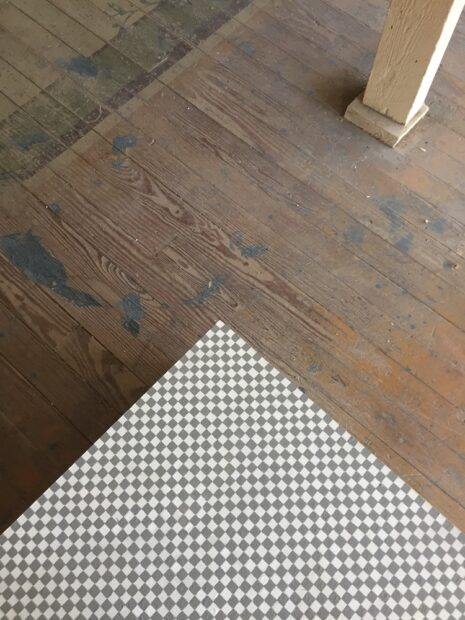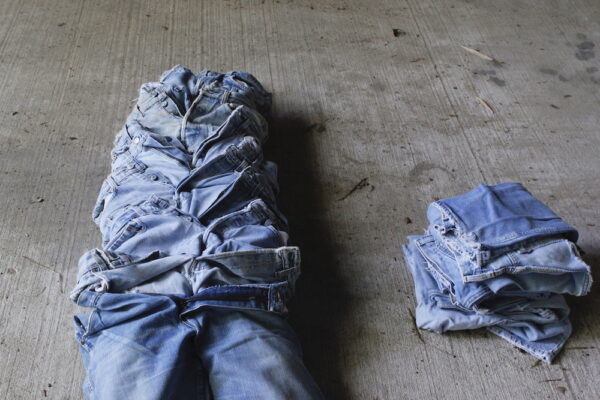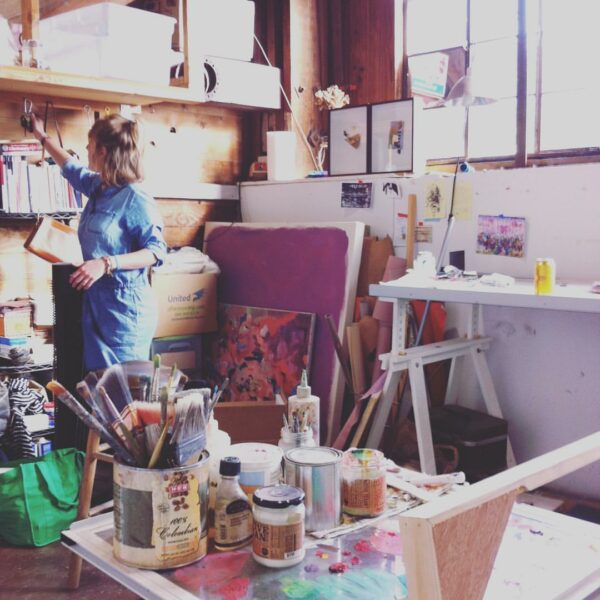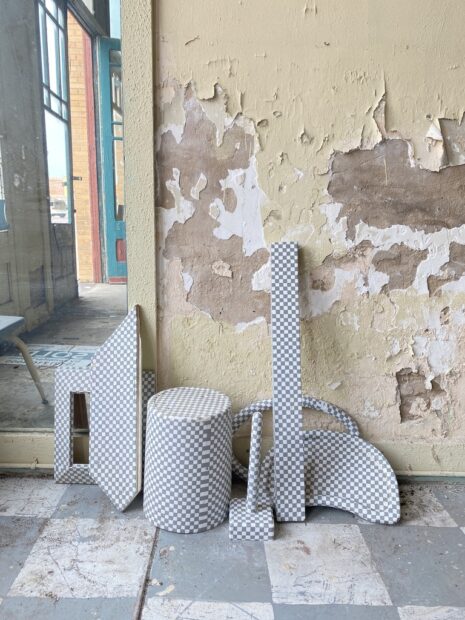
An installation detail shot of a work by Emmy Laursen (M.E. Laursen) at The Bartlett Project, 2021. In situ photos by Leslie Moody Castro
For the earlier installments in this series, please go here, here, here, here, and here, and here.
When ICOSA’s Jonas Criscoe and I started the conversation about The Bartlett Project, the first artist who came to our minds was Emmy Laursen. This project would require artists who could work collaboratively, would respect the existing communities and stories of the town, and could navigate their practice within the complications of the pandemic lock downs. As an individual and human being, Emmy was that person, and as an artist, she welcomed the challenges that flexibility required.
Not only did Emmy rise to the challenge — she did so with care, empathy, and gratitude. She has connected with the Bartlett Public Schools, and built a bridge that can last many years, all while nurturing her own formal art making-process by producing a series of sculptures The Bartlett Project exhibition.
I had a lot of respect for Emmy when we started this process, but through this project’s process, that respect has also grown into care and love. I can’t wait to continue watching her blossom as an artist and professional, and I have no doubt that Bartlett is the first of many things we’ll work on together.
Leslie Moody Castro: What interested you about the Bartlett Project when I approached you about it?
Emmy Laursen: I am interested in co-curation and collaboration as relationship-building. When you approached me about the project you were in the process of confirming participating artists, all of whom I know or had worked with before. I’m honored and excited to be part of and work in collaboration with this group of artists, led by your curatorial skills. Since we’re working in a community outside our own, I immediately put a lot of trust into the group of my fellow practicing artists.
I am also interested in the role of art in communities. A few questions I’m currently preoccupied with are: When and how does art function in economic and commercial development? How can art bring disparate communities together; when is art exploited for other purposes? I live in Austin, where it is no secret that artists and arts organizations are losing access to space. The lack of city infrastructure and waves of gentrification have greatly reduced arts organizations’ access to space for studios, exhibitions, or community gathering, leaving them weighing the responsibilities surrounding affordability, gentrification, and access. These considerations are ones I am processing in each of my identities as artist, arts organizer, curator, Austin resident, and human.
As artists, our unique tool sets allow us to navigate circumstances with curiosity. It is exciting that, as opposed to scrambling to show work with limited space, we are in a situation where The Bartlett Project presents a new opportunity for artists to explore. This has already resulted in community building, examining histories, engaging with the public school system, and more.
LMC: What were you looking forward to most in the beginning of The Bartlett Project?
EL: The entire project was forming during Covid, so I was thrilled to work toward something. During this past year, any project with a timeline has been energizing, and motivation for me to “keep chuggin’” along. I was excited to learn about the town of Bartlett, to see how individuals — primarily students and teachers in the school — relate to art; to work in conversation with the other artists’ practices; to document the process; and to interact with people I respect and admire!
LMC: What was your initial idea for the project and exhibition?
EL: Our role in the project was to “activate” the building. My practice involves formal and social or performance elements, and intended to host a two-part activation involving found objects and engaging students from the school in a collaborative installation.
I initially daydreamed of activating the space in Bartlett with a lot of ego. It was actually in Glasstire where I first heard the question:“What happens when you give Texas artists space?” In this instance, we were given a large space to do with what we wanted. I had to meet the semi-infinite openness in both curation and space with what the actual purpose of making work here was. While, like most space-starved Austin artists, I drool at the idea and challenge of filling a space, this approach was quickly revealed to be misaligned with myself and my practice.
LMC: Can you elaborate on that a little more?
EL: Like most artists, I do have visions of creating large installations when given space to do so. Upon reflection, however, it felt important to recognize the changes these spaces are undergoing. These are not art spaces that have the same expectations or audiences that art spaces have. The buildings in Bartlett were once businesses, and inherently also part of a community, and now are being transformed.
LMC: Can you talk a little bit more about the formal part of your two-part activation: specifically, the sculptures?
EL: Since the end of my BFA, my painting practice has consisted of painting on and/or with found objects, detritus, and hand-me-downs. In this project, I wanted to visually communicate the feeling of tension in the questions I’ve recently been asking myself while participating in an exhibition sited in spaces undergoing “revitalization.” When we first toured the historic buildings in downtown Bartlett, the interiors were being demolished: remnants of businesses, adornments, and debris covered the floors. The stories, history of objects, and lives that had existed in these spaces were still present — but were on their way out — and the new use of the space was knocking at the metaphorical door.
I chose to use these loaded objects as sorts of canvas/materials to grapple with these questions. This is not to say these were the original objects of businesses or that they belonged to residents of Bartlett, but there was something about not knowing what was here, and getting to interpret the history and layers of change of the space through objects. I painted the pattern of the base layer of Photoshop — that gray and white grid — on each of them, conveying the “new layer” or newness these spaces will be subject to.
LMC: What have you learned along the way?
EL: Through the process of making this work, I’ve come to the realization that art is an inherently human practice, and one that can be used as a tool for bridging experiences with others. Given this, it’s ironic that not everyone has access to it. As part of my research, I discovered that the Bartlett Independent School District does not have a regular year-round arts education program.
I’ve also learned there is not one singular narrative for any place or “community,” and that each person carries a perspective that can be honored if met with humility.
It was important for us — I think as a group — to determine who our audience was. At this point, I think we have a variety of intersecting audiences we are working to serve, engage, and exhibit to. This is the beauty of all the different practices we artists bring, that we can meet in a space where there is hopefully a narrative, representation, or form that piques everyone’s interest and invites them to ponder.

An installation detail shot of a work by Emmy Laursen (M.E. Laursen), dad’s whole life worth of denim, 2019
LMC: How do you think your part of the project has engaged with different audiences, and who are those audiences?
EL: I’m indirectly engaging with students, administrative staff, teachers, and other artists by collaborating with Rachel Fahrig, Special Programs Director at Bartlett Independent School District, to curate summer arts programming called “ArtBreak” while working closely with our own artist team. Inviting other artists in to participate in the project is special because it extends the opportunity to others to challenge their practice and support the goal of providing access to art. Participating artists have responded with great enthusiasm and gratitude for the opportunity to contribute.
As for the sculptures, I think they speak to my reflection of being a white artist who moved to Austin as a student some years ago. In my time in the city, I have experienced — both first and secondhand — moving studio, exhibition, and living spaces as the result of commercial development projects that aim to revitalize or ‘make better use’ of space in the city. Through my sculptures I want to reference that metaphorical ‘base layer’ that, for me, is what developers ‘read’ or ‘see’ in spaces that are filled with the evidence of lives lived. I want to bring attention to these rapid cycles that happen through layers of construction that involve objects, materials, and the detritus of life — all of which come with these overhauls.
In the physical sculptures themselves, the new layer of gray and white cannot negate the presence of the past life of the object it is painted on top of. I hope that my fellow artists, students in my local community, and residents of both Bartlett and Austin are able to engage with and reflect on this process of revitalization. Through the metaphorical layers that are a really common language in Photoshop, I have been able to reflect on this process of revitalization and how it can coexist with and sometimes on top of our past.
LMC: How has the nature of your work changed through the process?
EL: My intention in this project was to practice being present. I wanted to approach the process of making with mindfulness, and considered the question: “Are my actions honoring myself and those around me?” This helped me balance being flexible, optimistic, and patient with our team flow, and with moving forward with my own work, and through discussion and brainstorming with Fahrig [about the aforementioned] “ArtBreak” program — an arts element in the summer camp held for K-5th grade, which consists of a curated roster of instruction by regional practicing artists. We are currently in the process of funding and scheduling artists for the program. [If you’d like to donate or get involved in this project, please go here.]
LMC: Can you talk a little about the personal realization of that question: “Are my actions honoring myself and those around me”?
EL: This question comes up in my personal meditation practice, my recovery practice, and in my coursework as an aspiring mental health professional. Applying it to my art practice proved really fruitful and also particularly appropriate in this instance. Because I’m thinking about what each new instance of development or “revitalization” brings to a place, I’m realizing the possibilities of how I can answer this question. I want it, for myself and others, to be a question of self-reflection and honesty that leads to the realization of abundance in what surrounds us — our community, our family, our access, etc.
However, the sculptures only have the pattern of a “new layer” painted on them, so they can become whatever I or the viewer project onto them: they can contain a projection of myself; for a developer they may signify the gains to be made in the overhaul of a space; for a child they may be imbued with dreams. I want to acknowledge, though, the trap or illusion of the new that exists alongside the hope — these are not “new” objects, just as this is not a “new” space — however, it is the community, relationships, and purpose put into and enacted within the space that can “activate” and “revitalize” a space with lived meaning.
To learn more about Bartlett, please follow @downtownbartlett. Next installment: Two weeks.




